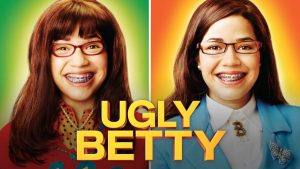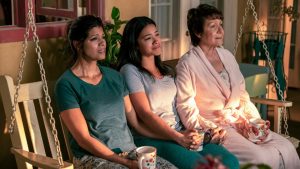Temps de lecture : 11 minutes
References
| ↑1 | Latinx is a word used in the United States by the Latin American immigrant community, immigrating to the United States, to describe themselves in a more gendered way (Latino being used to refer to men and Latina to women). This term will be preferred to its gendered synonyms when referring to the community in general, in order to use the words by which individuals define themselves. |
|---|---|
| ↑2 | Intersectionality is a term developed by Kimberlé Crenshaw in 1989. It defines the experience and identity of any individual at the intersection of several social categories (gender, race, class, sexual orientation, disability, etc.); the totality of these categories together defining a person’s identity. |
| ↑3 | Latina is a term that defines women of Latin American descent who have immigrated to the United States for one or more generations. This term will be used when discussing the female characters. |
| ↑4 | Lysiane Colin, “The Place of Intersectionality in American TV Series: Diversity in the World of Shondaland 1/2”, Gender Institute in Geopolitics, 24 June 2021, https://igg-geo.org/?p=3662. |
| ↑5, ↑8 | Caroline Grell, ‘The Fight for Equality: The Role of Latino Stereotypes in Jane the Virgin’, Elon Journal of Undergraduate Research in Communications, vol.8, no.1, 2017, p.35. |
| ↑6, ↑34, ↑35 | Ibid. |
| ↑7 | Nicole Acevedo, “TV shows struggle to reflect U.S. Latino presence. Will it get better?”, May 24, 2019, NBC News, https://www.nbcnews.com/news/latino/producers-latino-themed-tv-shows-fight-stay-n989561. |
| ↑9 | Op. cit. Caroline Grell, “The Fight for Equality: The Role of Latino Stereotypes in Jane the Virgin”. p.36. |
| ↑10, ↑18, ↑20 | Op. cit. Nicole Acevedo, “TV shows struggle to reflect U.S. Latino presence. Will it get better? |
| ↑11 | Op. cit. Caroline Grell, ‘The Fight for Equality: The Role of Latino Stereotypes in Jane the Virgin’, p.35. |
| ↑12 | Police shows of the 2000s have an impressive rate of Latino characters – predominantly male roles – in incarcerated characters, or perpetrators of illegal acts. |
| ↑13 | The character of a Latin Lover is represented by a suave, seductive, handsome, sexy Latino man who melts women and is very ‘masculine’ in his features and behaviour. |
| ↑14 | The stereotype of the hypersexualised woman is notably represented through the character of Gabrielle in Desperate Housewives (2004-2012), played by Eva Longoria. She is not only a sexual object for the male characters, but her character also represents a young woman who marries rich men in order to have a high social status without having to work. |
| ↑15 | For example the character of Gloria in Modern Family (2009-2020), played by Sofia Vergara. Even though she represents one of the first Latina portrayals on television and is evolving into a more complex character, Gloria remains a loud woman with a very strong accent who finds herself at the centre of jokes, particularly for her Colombian origin. She is also very beautiful and is sexualised through her clothes and the way men look at her. |
| ↑16 | Jennifer Lopez’s role in Maid in Manhattan (2003) is an example of this type of stereotype. Jennifer Lopez plays Marisa, a young woman who works as a maid in a New York hotel. Although she is an upright character who works in order to raise her son, she is categorised as a ‘cleaning lady’. |
| ↑17 | Gwen Aviles, “The Impact Of ‘Jane The Virgin’ Cannot Be Overstated”, 28 September 2020, HuffPost, https://www.huffpost.com/entry/jane-the-virgin-series-finale-latinx-representation_n_5d4486c2e4b0acb57fcc4b1a. |
| ↑19, ↑21 | Op. cit. Caroline Grell, “The Fight for Equality: The Role of Latino Stereotypes in Jane the Virgin”, p.36. |
| ↑22 | Op. cit. Caroline Grell, “The Fight for Equality: The Role of Latino Stereotypes in Jane the Virgin”, p.37. |
| ↑23 | Gwen Aviles, “‘Ugly Betty’ Gave Television An Unlikely Latina Heroine”, HuffPost, December 1, 2020, https://www.huffpost.com/entry/ugly-betty-silvio-horta-latino-representation_n_5e18a3dfc5b6da971d14ffd9. |
| ↑24 | Body positivity is a movement that advocates the acceptance of all female bodies as they are. It was created in the United States in 1996 by Connie Sobczak and Elizabeth Scott and has gained notoriety thanks to social networks. More information: Alexandra Sastre, “Towards a Radical Body Positive”, Feminist Media Studies, vol.14, no.6, 24 February 2014, pp.929-943. |
| ↑25 | Op. cit. Caroline Grell, ‘The Fight for Equality: The Role of Latino Stereotypes in Jane the Virgin’, p.43. |
| ↑26, ↑33, ↑38 | Caroline Grell, « The Fight for Equality: The Role of Latino Stereotypes in Jane the Virgin », Elon Journal of Undergraduate Research in Communications, vol.8, n°1, 2017, p.35. |
| ↑27 | Perla Farías is a Venezuelan screenwriter and producer. |
| ↑28 | Jennie Snyder Urman is a US-based writer and producer. |
| ↑29 | Ibid, p.35. |
| ↑30 | Diana Martinez, ” Jane the Virgin Proves Diversity Is More Than Skin Deep “, The Atlantic, 19 octobre 2015, https://www.theatlantic.com/entertainment/archive/2015/10/jane-the-virgin-telenovelas/409696/. |
| ↑31 | Paola Brembilla et Lucia Tralli, ” ‘With 22 episodes a year’ Searching for Quality in US Network Television : the Cases of The Good Wife, Brooklyn Nine-Nine and Jane the Virgin “, Comunicazioni sociali, n°2, 2015, p.148. |
| ↑32 | Juan Piñón, ” Jane the Virgin. The Pursuit of New Latina/o Representations “, automne 2017, ReVista Harvard Review of Latin America, p.23-24, URL : https://archive.revista.drclas.harvard.edu/book/jane-virgin. |
| ↑36 | Op. cit. Diana Martinez, ” Jane the Virgin Proves Diversity Is More Than Skin Deep “. |
| ↑37 | Denicia Sam Cadena, ” Opinion : ‘Jane the Virgin’ Abortion Storyline a Nuanced Latinx Portrayal “, NBC News, 27 octobre 2016, https://www.nbcnews.com/news/latino/opinion-jane-virgin-abortion-storyline-nuanced-latinx-portrayal-n673286. |
| ↑39 | Geraldine Cols Azócar, « Proud to be Latinx and represent: ‘One Day at a Time’s’ Isabella Gomez », NBC News, 21 septembre 2018, https://www.nbcnews.com/news/latino/proud-be-latinx-represent-one-day-time-s-isabella-gomez-n911646. |


